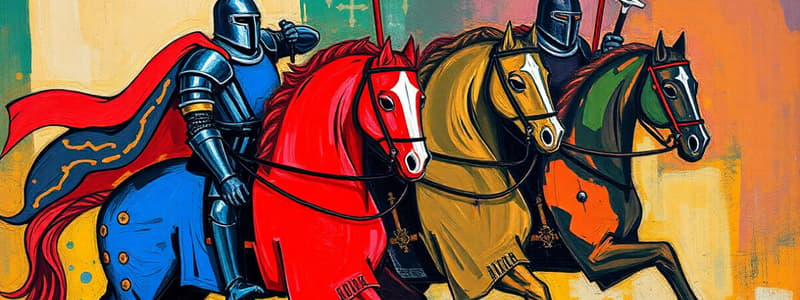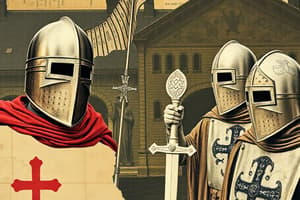Podcast
Questions and Answers
Which institution primarily controlled education after the fall of the Roman Empire?
Which institution primarily controlled education after the fall of the Roman Empire?
- The Government
- The Guilds
- The Church (correct)
- The Monasteries
What were boys taught in the Elementary-song schools?
What were boys taught in the Elementary-song schools?
- Arithmetic, geometry, music, astronomy
- Law, medicine and theology
- Grammar, rhetoric, logic
- Reading, writing, and singing (correct)
Which of the following was NOT a faculty in the medieval universities?
Which of the following was NOT a faculty in the medieval universities?
- Faculty of Arts
- Faculty of Medicine
- Faculty of Law
- Faculty of Engineering (correct)
Which group of subjects comprised the Quadrivium?
Which group of subjects comprised the Quadrivium?
How were the children of peasants typically educated?
How were the children of peasants typically educated?
What did landownership provide to the nobility?
What did landownership provide to the nobility?
What was a knight's life guided by?
What was a knight's life guided by?
At what age did a boy typically become a squire?
At what age did a boy typically become a squire?
What was one of the main responsibilities of the clergy?
What was one of the main responsibilities of the clergy?
Where did many people live under special religious communities?
Where did many people live under special religious communities?
Which of the following was a main function of monasteries?
Which of the following was a main function of monasteries?
Who took care of sick people?
Who took care of sick people?
What task was performed by priests in the monasteries?
What task was performed by priests in the monasteries?
Who were usually the only educated people in a community?
Who were usually the only educated people in a community?
Who authored the rules for monks and nuns?
Who authored the rules for monks and nuns?
Flashcards
Song Schools
Song Schools
Elementary schools connected to churches.
Monastic Schools
Monastic Schools
Schools located within monasteries, taught by monks.
Grammar Schools
Grammar Schools
Schools established by bishops as part of cathedrals or large churches.
University Faculties
University Faculties
Signup and view all the flashcards
Trivium
Trivium
Signup and view all the flashcards
Nobility in the Middle Ages
Nobility in the Middle Ages
Signup and view all the flashcards
Knights
Knights
Signup and view all the flashcards
Code of Chivalry
Code of Chivalry
Signup and view all the flashcards
Stages of Knight Training
Stages of Knight Training
Signup and view all the flashcards
Clergy
Clergy
Signup and view all the flashcards
Monasteries and Convents
Monasteries and Convents
Signup and view all the flashcards
Three Main Functions of Monasteries
Three Main Functions of Monasteries
Signup and view all the flashcards
Monastic Healthcare
Monastic Healthcare
Signup and view all the flashcards
Monastery Administration
Monastery Administration
Signup and view all the flashcards
Monastery Education
Monastery Education
Signup and view all the flashcards
Study Notes
The Nobility
- They could own land, bringing political power and wealth.
- They were judges and members of councils.
- They attended a king during his journeys.
- They provided military support, collected taxes, and provided food and shelter for a king and people traveling with him.
The Knights
- Supposed to fight for their king and country.
- Educated and well-trained, it was guided by "Code of Chivalry".
- Code of Chivalry was a complex set of strict rules.
- Code of Chivalry promoted loyalty, bravery, and respectfulness.
- Knights who served in Code of Chivalry should loyal to a feudal lord, heavenly Lord, and a chosen lady.
- Code of Chivalry implied protection of the weak and the poor.
- Knights fought only against the men of the same rank.
- There were three stages of training and education: Page, Squire, Knight.
- Page age: 7-14.
- Boys usually lived at a castle of a knight.
- They practiced conduct, fencing, riding a horse.
- Squire age: 14-20.
- Boys became the attendants of a knight.
- They practiced launching arrows, hunting.
- Knight age: 21.
- Achieved a knighthood.
The Clergy
- The people who were anointed dedicated their lives to serving God.
- Members of clergy were supposed to provide religious services.
- Clergymen who held higher offices in the Church could own the land.
- Clergymen were wealthy and held political power.
- Many people lived in the special religious communities: monasteries (monks) and convents (nuns).
- The life of monks and nuns was guided by the strict and practical rules.
- Monasteries had three main functions: healthcare, administration, and education.
- Healthcare: monks in monasteries took care of sick people.
- Administration: priests wrote chronicles and took the record of the events.
- Education: Monks were usually the only educated people in a community and they provided the education for children.
- Benedict and Scholastica were authors of the rules for monks and nuns.
Education
- Education was in decline after the fall of the Roman Empire.
- Education was taken under the control by the Church.
- The Church established three types of the schools: Elementary-song schools, Monastic schools, and Grammar schools.
- Elementary-song schools were a part of the church in a town and boys were taught reading, writing, and singing.
- The Monastic schools were a part of monastery and the monks were the teachers, learning was by heart without actual understanding.
- The Grammar schools were a part of the cathedral or large church.
- Grammar schools were established by the bishops and basic subjects were taught.
The Universities
- Provided a higher education.
- Started as the small groups of scholars.
- Four Faculties: Faculty of Theology, Faculty of Law, Faculty of Medicine, Faculty of Arts.
Septem Artes Liberals - The Seven Liberal Arts
- Trivium: grammar, rhetoric, logic.
- Quadrivium: arithmetic, geometry, music, astronomy.
- Only wealthy people could afford to study, there were high fees and expensive books.
- The education was time-consuming.
- Noble boys attended schools and noble girls were taught at home.
- Education was expensive for the peasants and they had to have the approval of their lord if they wanted to attend school.
- The children of peasants were usually educated at home and they learned by simulation of the work of the adults.
- They practiced the skills in farming and technical skills.
- Traditions, folk-tales, proverbs and fairy-tales were important part of the education.
- The sermons and confession in the churches had educational purposes too.
Studying That Suits You
Use AI to generate personalized quizzes and flashcards to suit your learning preferences.




